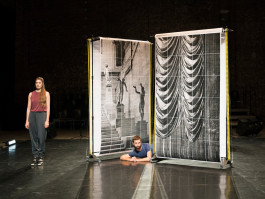
I know it when I see it
Performance
2019
It is common to hear dance professionals discuss the authenticity and sincerity of movement using words such as “real”, “natural”, “emergent”, and “spontaneous”. This is part of a larger discussion about what is fake, pretentious, or simulated, and what is “real” in art.
When trying to say what constitutes hard-core pornography, US Supreme Court Justice Potter Stewart said “perhaps I could never succeed in intelligibly doing so. But I know it when I see it”. This summarises the irony and difficulty of trying to find a definition for a concept that is subjective and lacks clear parameters.
In this piece, that I co-created with Luísa Saraiva and the collaboration of Frances Chiaverini, we wished to explore the dimensions of misrepresentation, bluffing, deception, mindlessness and nonsense in dancing. Can we tell “authentic” dancing? Is it worse if we know it’s not? Can we really know it when we see it?
To test our assumptions, we developed an interview score that we named “Counselling for future dances”. It is an exercise of guided imagination that addresses the desires, wishes, and interests of performers, and how they describe and experience their work.
In early 2019, we used this score to interview 45 professional dancers – all of them working in the various contexts and styles usually referred to as “contemporary dance” – from their early 20’s to their mid 40’s, representing 17 different nationalities and living in 14 different European cities with strong dance scenes. We recorded the interviews.
We then analysed the answers using methods such as content analysis, in collaboration with a psychology scholar, in order to try to create a collective overview of group awareness.
The basis for the dialogue, movements, and attitudes of I know it when I see it comes from the interviews with these 45 dancers. Their imaginary dances were reenacted, reinterpreted, and bastardised by us.
We bluffed our way through it, and even if we faked it, we probably got it right.
Shows
Festival Circular
at Teatro Municipal de Vila do Conde, PT
September 19, 2019
Maschinenhaus, Essen, DE
October 30–31, 2019
Concept, direction, and performance
Carlos Azeredo Mesquita
Luísa Saraiva
Artistic collaboration and performance
Frances Chiaverini
Set design
Carlos Azeredo Mesquita
Music
Julius Gabriel
Costumes
João Rôla
Text and content analysis
João Francisco Barreto
Light design
Rui Barbosa
Sound design
Ricardo Cabral
Interview subjects/choreographic material in partnership with
Aaron Davis, Alejandro Russo, Alexandre Archour, Ana Renata Polónia, Ana Rita Teodoro, Angela Diaz Quintela, Beniamin Boar, Blanca Noguerol Ramirez, Bryan Campbell, Catarina Miranda, Charlotte Virgile, Claire Vivienne Sobottke, Cristina Planas Leitão, Cyril Baldy, David Marques, Filipe Pereira, Francisco Pinho, Frank Willens, Ine Claes, Inês Campos, Jacob Storer, João dos Santos Martins, Johann Geidies, Jorge Puerta Armenta, Leyla Postalcioglu, Marco da Silva Ferreira, Marcus Baldemar, Margaux Marielle-Trehoüart, Maria Ferreira Silva, Meri Pajunpää, Michael Helland, Montserrat Gardó Castillo, Pedro Prazeres, Petr Hastik, Renan Martins de Oliveira, Rósa Ómarsdóttir, Sheena McGrandles, Simon Hartmann, Theo Livesey, Tiago Coelho, Tilman O’Donnell, Tyshea Suggs, Vincenzo Carta
Produced by
Carlos Azeredo Mesquita
Luísa Saraiva
Co‐produced by
Festival Circular
with the support of
Maschinenhaus Essen
Funded by
Kunststiftung NRW
Fundação Calouste Gulbenkian
Porto City Council/Shuttle
DGArtes – Direcção-Geral das Artes/República Portuguesa
Goethe Institut
Stadt Essen Kulturbüro
Supported by
Espaço do Tempo
Teatro Municipal do Porto
Circolando
Armazém 22
Companhia Instável
Duration
50 minutes
Watch the full 50 minutes video documentation
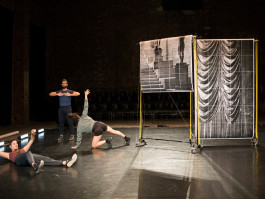
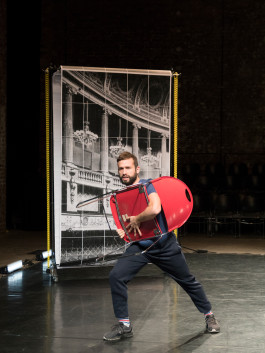
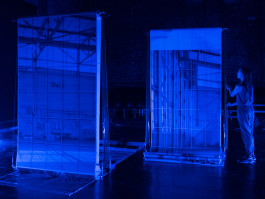
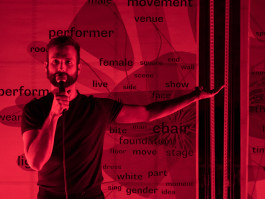
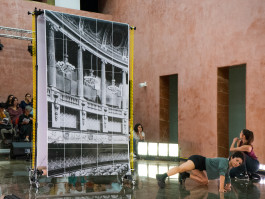
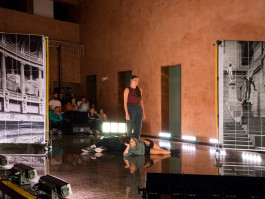
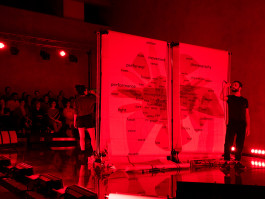
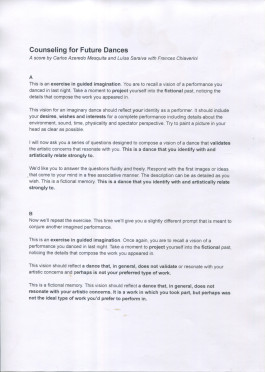
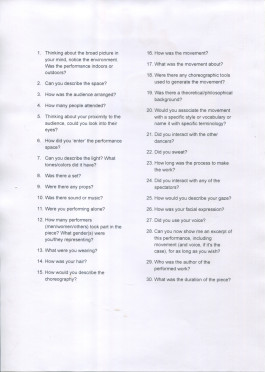
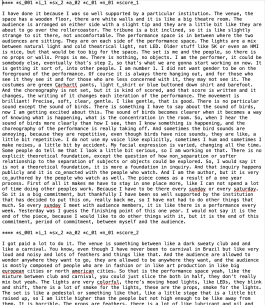
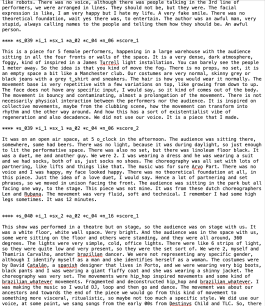
Shows / Photo credits
1–5
Maschinenhaus Essen / Sofia Arriscado
6–8
Festival Circular at Teatro Municipal de Vila do Conde / Festival Circular

I know it when I see it
Performance
2019
It is common to hear dance professionals discuss the authenticity and sincerity of movement using words such as “real”, “natural”, “emergent”, and “spontaneous”. This is part of a larger discussion about what is fake, pretentious, or simulated, and what is “real” in art.
When trying to say what constitutes hard-core pornography, US Supreme Court Justice Potter Stewart said “perhaps I could never succeed in intelligibly doing so. But I know it when I see it”. This summarises the irony and difficulty of trying to find a definition for a concept that is subjective and lacks clear parameters.
In this piece, that I co-created with Luísa Saraiva and the collaboration of Frances Chiaverini, we wished to explore the dimensions of misrepresentation, bluffing, deception, mindlessness and nonsense in dancing. Can we tell “authentic” dancing? Is it worse if we know it’s not? Can we really know it when we see it?
To test our assumptions, we developed an interview score that we named “Counselling for future dances”. It is an exercise of guided imagination that addresses the desires, wishes, and interests of performers, and how they describe and experience their work.
In early 2019, we used this score to interview 45 professional dancers – all of them working in the various contexts and styles usually referred to as “contemporary dance” – from their early 20’s to their mid 40’s, representing 17 different nationalities and living in 14 different European cities with strong dance scenes. We recorded the interviews.
We then analysed the answers using methods such as content analysis, in collaboration with a psychology scholar, in order to try to create a collective overview of group awareness.
The basis for the dialogue, movements, and attitudes of I know it when I see it comes from the interviews with these 45 dancers. Their imaginary dances were reenacted, reinterpreted, and bastardised by us.
We bluffed our way through it, and even if we faked it, we probably got it right.
Shows
Festival Circular
at Teatro Municipal de Vila do Conde, PT
September 19, 2019
Maschinenhaus, Essen, DE
October 30–31, 2019
Concept, direction, and performance
Carlos Azeredo Mesquita
Luísa Saraiva
Artistic collaboration and performance
Frances Chiaverini
Set design
Carlos Azeredo Mesquita
Music
Julius Gabriel
Costumes
João Rôla
Text and content analysis
João Francisco Barreto
Light design
Rui Barbosa
Sound design
Ricardo Cabral
Interview subjects/choreographic material in partnership with
Aaron Davis, Alejandro Russo, Alexandre Archour, Ana Renata Polónia, Ana Rita Teodoro, Angela Diaz Quintela, Beniamin Boar, Blanca Noguerol Ramirez, Bryan Campbell, Catarina Miranda, Charlotte Virgile, Claire Vivienne Sobottke, Cristina Planas Leitão, Cyril Baldy, David Marques, Filipe Pereira, Francisco Pinho, Frank Willens, Ine Claes, Inês Campos, Jacob Storer, João dos Santos Martins, Johann Geidies, Jorge Puerta Armenta, Leyla Postalcioglu, Marco da Silva Ferreira, Marcus Baldemar, Margaux Marielle-Trehoüart, Maria Ferreira Silva, Meri Pajunpää, Michael Helland, Montserrat Gardó Castillo, Pedro Prazeres, Petr Hastik, Renan Martins de Oliveira, Rósa Ómarsdóttir, Sheena McGrandles, Simon Hartmann, Theo Livesey, Tiago Coelho, Tilman O’Donnell, Tyshea Suggs, Vincenzo Carta
Produced by
Carlos Azeredo Mesquita
Luísa Saraiva
Co‐produced by
Festival Circular
with the support of
Maschinenhaus Essen
Funded by
Kunststiftung NRW
Fundação Calouste Gulbenkian
Porto City Council/Shuttle
DGArtes – Direcção-Geral das Artes/República Portuguesa
Goethe Institut
Stadt Essen Kulturbüro
Supported by
Espaço do Tempo
Teatro Municipal do Porto
Circolando
Armazém 22
Companhia Instável
Duration
50 minutes
Watch the full 50 minutes video documentation











Shows / Photo credits
1–5
Maschinenhaus Essen / Sofia Arriscado
6–8
Festival Circular at Teatro Municipal de Vila do Conde / Festival Circular